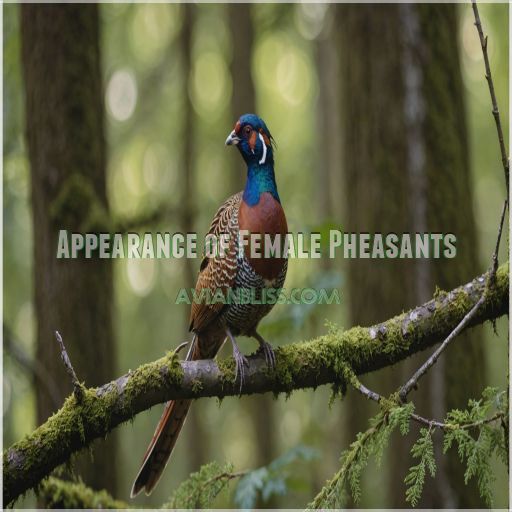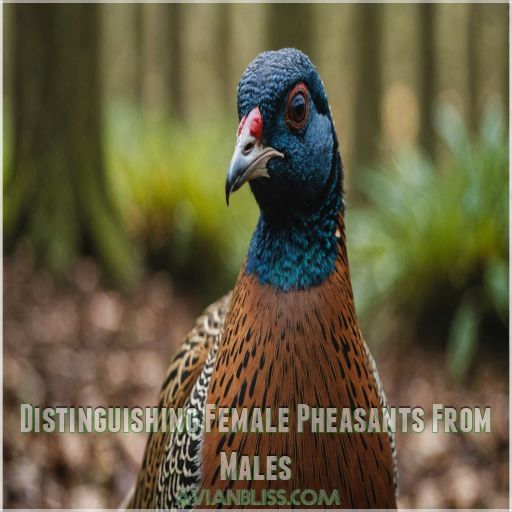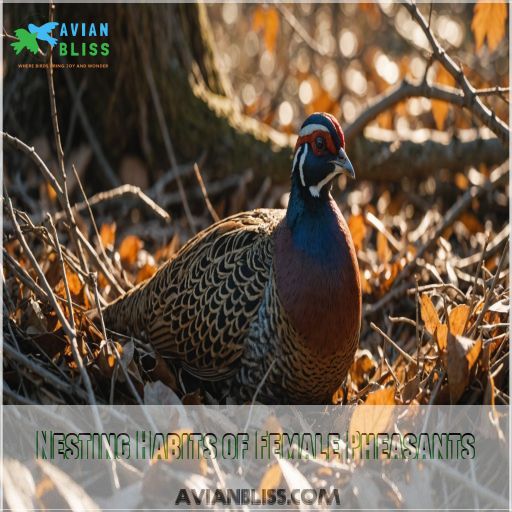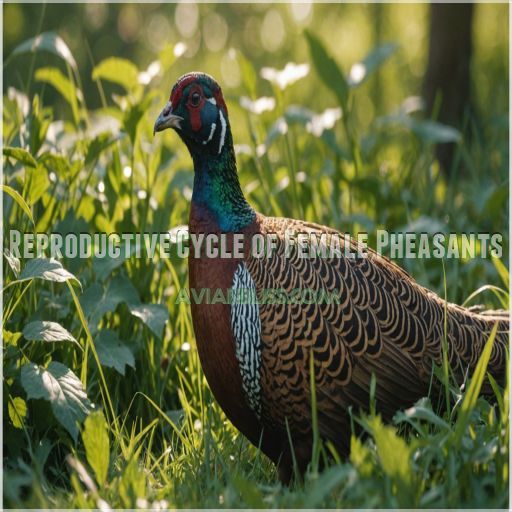This site is supported by our readers. We may earn a commission, at no cost to you, if you purchase through links.

With her dull, mottled brown feathers, she’s the ultimate master of disguise, blending seamlessly into her surroundings to dodge predators.
Smaller and less flashy than her male counterpart, she’s got a cooperative spirit—often joining other females in social flocks.
Her calls are subtle, yet essential for communication and keeping her chicks safe. She constructs clever nests, hidden from view, and she fiercely guards her eggs.
Despite a quieter presence, she’s a force of nature. She’s also a master of disguise, and the ultimate female pheasant, in her own right. Stick around; there’s much more to uncover about these fascinating birds.
Table Of Contents
- Key Takeaways
- Appearance of Female Pheasants
- Distinguishing Female Pheasants From Males
- Female Pheasant Behavior and Social Dynamics
- Nesting Habits of Female Pheasants
- Reproductive Cycle of Female Pheasants
- Female Pheasant’s Role in Raising Chicks
- Flight Capabilities of Female Pheasants
- Habitat Preferences of Female Pheasants
- Conservation and Management of Female Pheasants
- Female Pheasants in Different Species
- Frequently Asked Questions (FAQs)
- What is a female pheasant called?
- How can you tell a female pheasant?
- Is a female pheasant a hen?
- Do female pheasants have tails?
- What do female pheasants eat in the wild?
- How do female pheasants find food?
- What predators threaten female pheasants?
- How do female pheasants adapt to seasonal changes?
- What role do female pheasants play in ecosystem balance?
- Conclusion
Key Takeaways
- You’re in for a treat with female pheasants, known as "hens" – masters of camouflage with their mottled brown feathers that keep predators guessing all day long. Think of them as the ninjas of the bird world!
- Ever wonder what these hens eat? They love a mixed diet of insects, seeds, and grains, like nature’s tastiest salad. And yes, they have a knack for finding food, effortlessly scratching the ground or hopping to snag a juicy fruit.
- In the grand scheme of the ecosystem, female pheasants play the role of underappreciated custodians. From controlling pests to aiding seed dispersal, they have a hand in balancing nature like seasoned professionals.
- When it comes to nesting, female pheasants are the ultimate multitaskers. Not only do they construct hidden nests with finesse, but they also valiantly defend them from hungry predators, often employing some crafty "distraction tactics" worthy of an Oscar.
Appearance of Female Pheasants
You’re about to uncover the hidden beauty of female pheasants, nature’s master of disguise.
Their dull, mottled buff-brown feathers mightn’t turn heads like their male counterparts, but they’re a marvel of evolutionary camouflage that keeps these birds safe and sound in the wild.
Plumage Coloration and Patterns
Nature’s artistry shines in female pheasant plumage. You’ll be amazed by their subtle beauty, designed for camouflage. Unlike their flashy male counterparts, hens sport mottled earth tones that blend seamlessly with their surroundings.
This evolutionary masterpiece serves a vital function: protection. Female pheasants also have a pale belly and plain olive-buff for nest concealment, which helps them blend in with their environment ring-necked pheasant habitat.
Seasonal variations and regional differences add depth to their appearance, with some sporting whitish tail tips in the Rockies. Lady Amherst’s pheasants take it up a notch with their unique patterns, proving that subtlety can be stunning.
Size and Body Structure
Swapping vibrant plumage for a subtler palette, female pheasants present a fascinating study in size and body structure. Weighing around 2 pounds, they boast a compact body shape, perfect for ground dwelling.
Their modest wingspan complements a shorter tail, unlike their flashy male counterparts.
Ever notice how their foot size fits the bill for swift, stealthy escapes? It’s an avian marvel!
Head and Facial Features
Admire the female pheasant’s understated elegance.
Her head and facial features crave attention. Notice the:
- Subtle eye color variations that intrigue observers
- Gentle facial markings, a reflection of nature’s artistry
- Unique bill shape and modest head size
These delightful birds maintain a grace that belies their role in bird mating and nesting cycles, showing power in simplicity.
Tail Characteristics
Feeling curious about female pheasants’ tails? These ladies sport a long, elegantly barred tail, perfect for a dramatic exit!
Their coloration, a subtle mix of browns, aids in camouflage.
The tail’s shape and feather patterns aren’t just for show; they play a role in balance and steering.
In bird conservation, understanding such traits enriches our appreciation of the common, ring-necked pheasant.
Eye and Beak Description
Female pheasants mightn’t have the flashiest eyes, but their subtle brown hues hold a charm of their own.
With their olive beaks, perfectly shaped for foraging, these birds pull off rustic elegance beautifully.
Those keen eyes and versatile beaks hint at stories untold, attracting bird watchers everywhere with their diverse eye colorations.
Distinguishing Female Pheasants From Males
Can you tell a female pheasant from a male just by looking at them?
You bet!
While the males are decked out in vibrant colors, the ladies rock a more subtle, mottled brown look that helps them blend right into the surroundings, giving them perfect mottled brown camouflage.
Key Physical Differences
Spotting a female pheasant next to a male is like comparing a gentle watercolor to a vibrant oil painting.
She sports sandy-brown plumage patterns, blending in with her surroundings while he flaunts striking colors.
Her smaller size, shorter tail length, and subtler head features contrast with the male’s bold red eye patches and colorful beak—true avian fashion .
Behavioral Contrasts
While male pheasants strut with flair, females often opt for subtlety through socialization.
You’ll find them in groups, especially during nesting seasons, avoiding the aggression males display.
Their foraging is more community-focused, balancing communication and harmony with their peers.
So, the charming secret in their world lies in the art of understated cooperation, rather than flashy displays.
Vocalization Variations
Ever wonder how to tell female pheasants apart from their flashy male counterparts? Their calls hold the key!
You’ll find female vocalizations exhibit unique traits:
- Brooding calls are calm for chick communication.
- Stress calls ramp up excitement or danger signals.
- Seasonal changes? They adapt with different pitch and volume.
Nature’s soundtrack is quite the orchestra, isn’t it?
Size Comparison
Uncovering the secrets of pheasant size reveals fascinating contrasts.
Female pheasants sport a lighter weight, shorter wingspan, and a daintier tail length compared to their larger male counterparts.
Picture a petite lady alongside a burly gent, much like this avian duo.
Females also have a smaller body length and head size, making them truly distinct.
Plumage Distinctions
Of course, size matters, but let’s pluck out the real secret: plumage. Female pheasants wear nature’s camouflage—like a cozy brown sweater in a world of blingy tuxedos.
Here’s how to spot them:
- Feather Patterns: Subtle motifs keep them hidden.
- Color Variation: Earthy tones reign supreme.
- Plumage Evolution: Adaptations guarantee survival.
- Species Differences: Each wears a unique coat.
Female Pheasant Behavior and Social Dynamics
If you’ve ever wondered how female pheasants manage their social lives, you’re not alone.
They form flocks with a knack for cooperation and communicate using subtle calls.
They even find time to snack while keeping a wary eye out for predators, proving that teamwork is more than a survival skill.
Flock Interactions
Your flock’s social hierarchy is key to understanding female pheasant dynamics.
Dominant hens command the best roosting spots and food sources, while subordinates must be savvier to survive.
Subtle communication signals, like head bobs and wing flicks, convey status and intent during breeding squabbles over resources.
Sharing food with chicks strengthens family bonds and helps the next generation thrive.
| Behavior | Dominant Hens | Subordinate Hens |
|---|---|---|
| Roosting | Prime spots | Peripheral areas |
| Feeding | First access | Scraps |
| Communication | Assertive | Submissive |
| Breeding | Active | Passive |
| Chick Rearing | Nurturing | Supportive |
Territorial Behavior
Imagine a female pheasant, fiercely defending her territory against male aggression while balancing harem formation and nest defense.
She navigates these territorial disputes like a pro, warding off challengers and deftly handling food competition.
Her savvy approach to nest security and resource management makes her a master of survival, turning her home into an unassailable fortress.
Communication Methods
Guarding their turf with style, female pheasants are masters of communication.
Through alarm calls and chick signals, they keep the family safe as a vault. Mating calls sparkle like bird calls, while distress signals scream, "Houston, we’ve a problem!"
Flock cohesion is their social glue, binding them tighter than a group of best friends.
Foraging Habits
After the chatter and clucks, you’ll find pheasant hens digging in. They’re masters of foraging, often seen in open habitats like fields and pastures, where they forage on the ground in mixed flocks with other bird species, much like the female cowbird’s ground foraging tactics.
During autumn, they focus on energy-rich grains, while in summer, juicy insects become their buffet, a behavior also seen in cowbirds who adapt their diet to the season.
It’s a competitive game, yet they manage with finesse.
- Diet: Grains and insects.
- Seasonal variations: Adapt to available food.
- Competition: Constant yet balanced.
Predator Avoidance Strategies
To outsmart predators, female pheasants employ crafty tactics. Their camouflage is excellent, blending perfectly with the landscape, making them invisible to foes.
With impressive flight speed, they dash away in no time.
Nest defense is essential, too, as they fiercely protect their brood. When danger looms, chick hiding becomes a game of hide and seek nature perfected.
Nesting Habits of Female Pheasants
You’d be amazed at how crafty female pheasants are in terms of nesting.
They pick out the perfect spot, often surrounded by tall grass, and create a simple ground scrape, making you wonder if they’ve a secret degree in architecture.
Nest Site Selection
Imagine being a female pheasant choosing a real estate for your brood.
You’d opt for spots with abundant ground cover, ensuring excellent nest concealment and predator avoidance.
Prioritize nest site factors like perennial grass to create the perfect hideaway.
It’s all about embracing that quiet habitat preference where your little ones can thrive without a hitch!
Nest Construction Techniques
Crafting the perfect nest is an art form for female pheasants.
They carefully gather grasses, leaves, and even their own feathers to line the shallow scrape they’ve carved into the ground.
The camouflaged nest blends seamlessly with the surrounding vegetation, shielding their precious eggs from prying eyes and hungry predators.
The art form of nest building requires careful attention to detail, resulting in a safe and protective space for the eggs.
Egg Laying Patterns
You’ll find female pheasants are quite the diligent nesters. Like female goldfinches, they’re more reserved and peaceful, focusing on foraging and sustaining their lineage, as they prepare to lay their eggs.
They often build their nests in saplings or shrubs, with a sturdy, compact cup made from plant fibers and rootlets similar nesting habits.
They lay an impressive clutch of 11 eggs, in lovely shades from olive-brown to blue-gray, during the spring and early summer (Source).
With a nesting frequency that embraces freedom, these pheasants rarely miss their schedule, making patience a key ingredient in their successful laying season.
Incubation Process
Consider the female pheasant’s incubation process, a true labor of love. She chooses the perfect nest site, lays about a dozen eggs, and then diligently incubates them for 23 to 28 days.
Abandoning the nest risks chick survival. This natural act of patience and dedication can often feel like she’s walking a tightrope.
- Nest site selection
- Egg laying frequency
- Incubation duration
- Nest desertion
- Chick survival rates
Nest Defense Strategies
Female pheasants aren’t sitting ducks in terms of nest defense.
They employ clever camouflage techniques, choosing discreet nest locations that blend into the environment.
When threats arise, they often use predator calls and distraction tactics to protect their brood.
It’s like a strategy, where every move is a plan for securing their chicks’ future in the wild.
Reproductive Cycle of Female Pheasants
Ever wondered how female pheasants manage their busy reproductive cycle?
Get ready to explore their world of charming courtship, strategic egg laying, and dedicated brood rearing, where each step is a survival dance that’s both fascinating and a little bit survival dance.
Mating Rituals and Partner Selection
In between the flutter and shuffle of courtship displays, female pheasants face the grand challenge of mate choice, much like female woodpeckers who also prioritize visual identifiers, such as prominent crests, when selecting a mate.
They prioritize males with impressive territoriality and leadership skills during the breeding season, seeking the best providers, a trait that echoes the resourcefulness of female woodpeckers when defending their nests.
- Long tails catch their eye.
- Dominant attitudes secure attention.
- Unique, engaging courtship dances seal the deal.
Egg Production and Laying
As pheasants engage in their elaborate mating rituals, you’re likely wondering about the next step—egg production and laying.
Female pheasants lay clutches of 8 to 15 eggs with striking coloration. Their laying frequency varies, but nesting success depends on clutch size and careful site selection.
It’s nature’s frenetic dance, keeping you guessing and ultimately freeing those precious eggs into the world.
Incubation Period
Once the hen lays her clutch of 12 eggs, she’ll diligently incubate them for around 23 days.
Maintaining the nest temperature between 99-101°F is essential for the eggs’ viability.
During this time, the devoted mother rarely leaves the nest, relying on her instincts to guarantee her chicks hatch successfully.
Her tireless parental care is truly remarkable.
Hatching Process
You’ve waited patiently during the 23-28 days of egg incubation, and now it’s showtime!
Female pheasants orchestrate a remarkable hatching process where chicks, covered in down with open eyes, break free.
These tiny explorers leave the nest immediately, driven by a sense of adventure.
They quickly follow the mother’s nesting behavior, starting their own life journey.
Brood Rearing
With chicks now hatched and raring to go, the female pheasant’s role shifts to brood rearing.
She becomes a steadfast guardian, leading her little explorers to prime food sources while keeping an eagle eye out for threats like nest predation.
Her secret weapon? Natural camouflage and parental care guarantee chick survival, proving her prowess in the wild.
Female Pheasant’s Role in Raising Chicks
When you’re curious about how female pheasants raise their chicks, think of them as single moms juggling it all.
They provide warmth and guidance and also teach their young to forage and evade predators, prepping them for independence.
Brooding Behavior
In the art of brooding, female pheasants exhibit determination, nurturing their chicks within the perfect nest site. Their brooding duration is a reflection of their dedication, ensuring chick development and predator defense.
Imagine a mother hen vigilantly watching over her young—a classic mix of grace and grit.
- Brooding duration
- Nest site preferences
- Chick development
- Predator defense
Feeding and Foraging With Chicks
After brooding, female pheasants lead their chicks with tender care, guiding them through grassy fields.
These little ones are quick learners, picking up seeds and insects with the skill of seasoned foragers.
Their mother’s watchful eye guarantees safe exploration, fostering growth and independence.
With each tasty morsel discovered, the chicks’ tiny wings seem ready to take on the world.
Teaching Survival Skills
Wandering with their young, female pheasants impart survival skills essential for fledging independence. They play energetic games of hide-and-seek, teaching predator avoidance and camouflage techniques. Like a master chef, they show effective food-finding, emphasizing nature’s buffet. Imagine nest-building lessons where sticks transform into the home they will need.
These hens are nature’s instructors, ensuring chicks are wise to the world.
- Learn camouflage tricks
- Master food finding
- Practice nest building
Protection From Predators
You’ve taught your chicks survival, but how do you keep them safe with predators lurking?
Female pheasants employ remarkable tactics like expert camouflage and nest defense.
| Strategy | Description |
|---|---|
| Camouflage | Blending with surroundings |
| Nest Defense | Protecting the nest from threats |
| Chick Safety | Ensuring safety through vigilance |
| Flight Tactics | Quick escapes when danger nears |
Their group behavior improves chick safety. It’s a tough gig but rewarding!
Chick Development Stages
Pheasant chicks hatch covered in fluffy down, ready to follow mom and forage for themselves.
Over the next 6 weeks, they’ll grow rapidly, gaining independence as their flight feathers develop.
Keep a close eye – chick mortality can be high, but with the right diet and shelter, most will thrive.
Flight Capabilities of Female Pheasants
You might think female pheasants just sprint around on the ground, but they’ve got some serious flight skills too.
While they prefer running to flying, when startled or threatened, they can zip through the air at speeds up to 60 mph, showing off their impressive adaptations for short, speedy escapes.
Wing Structure and Adaptations
Even without earning a pilot’s license, female pheasants skillfully balance their wingspan and wing loading for those brief, yet powerful, flights.
Their feathers and muscle anatomy help generate the lift needed to soar just enough to evade predators.
It’s all about the hustle with high-frequency wingbeats, ensuring these ground-dwellers can escape sticky situations with elegance.
Take-off and Landing Techniques
In the realm of flight, female pheasants master their take-off and landing like aerial artists.
With a quick wingspan flurry, launching at impressive takeoff speeds, they adjust to wind conditions gracefully.
Landing precision requires keen awareness of terrain impact, resembling a skilled gymnast sticking the landing.
Who knew these ladies could juggle skyward challenges with such finesse?
Flight Speed and Distance
From take-off to soaring, female pheasants exhibit unique flight speed variations. They can dash up to 60 mph when dodging predators, like a feathered rocket-powered escape! Their average cruising range is about 38-48 mph. Several factors influence this, similar to the female American kestrel’s rusty-brown plumage adaptations, which also involves predator evasion. Female American Kestrels also show unique agility, so it’s likely female pheasants’ flight capabilities are also influenced by their agility. – Predator evasion
- Wind impact
- Migration patterns
- Wingspan and lift
- Energetic bursts vs. sustained flight
Aerial Maneuvers
Female pheasants are like aerial acrobats, performing impressive maneuvers to dodge predators.
Their flight patterns, marked by quick bursts, showcase a surprising agility. With a modest wingspan, they excel in rapid take-offs and gliding techniques.
Aerial courtship is their stylish display. Who wouldn’t admire a bird that can outwit danger mid-air?
| Feature | Description | Note |
|---|---|---|
| Flight patterns | Quick bursts | Predator evasion |
| Wingspan comparison | Modest size | Quick maneuverability |
| Gliding techniques | Efficient glides | Energy conservation |
Seasonal Variations in Flight Behavior
You mightn’t know that female pheasants’ flight behavior changes with the seasons. During breeding season, short flights are essential for predator avoidance and nest defense. In winter, they roost to conserve energy, challenging their flight capabilities.
Key factors shaping their flight include:
- Migration patterns
- Food availability
- Predator pressure
Pheasants adapt like seasoned pilots facing life’s turbulence.
Habitat Preferences of Female Pheasants
You might be surprised to learn that female pheasants are quite the habitat specialists.
From preferring dense vegetation for roosting to adapting to agricultural landscapes, these birds know how to thrive in a variety of environments, specifically being habitat specialists.
Preferred Vegetation Types
While pheasants may seem like masters of flight, they’re also connoisseurs of cozy corners in grassy fields or marsh areas.
You won’t catch them settling for less when choosing their nest sites, preferring spots with lush vegetation for foraging habitat, winter cover, and nesting material.
These habitats help to guarantee successful brood rearing.
Roosting Sites
Tall grasses lure you with their whispers of freedom, perfectly masking roosting pheasants like all-natural invisibility cloaks. Female pheasants aren’t just picky shoppers; they select roosting sites based on safety and comfort.
Imagine this:
- Dense underbrush: A fortress against predators.
- Grassy fields: Yet another layer of protection.
- Quiet proximity to water: A dream habitat.
Safety and availability dictate their cozy retreats.
Seasonal Habitat Changes
Female pheasants have a knack for changing habitats seasonally to suit their needs.
In winter, they seek dense thickets for foraging. During breeding season, open fields are ideal destinations.
| Season | Habitat Type |
|---|---|
| Winter | Dense Thickets |
| Spring | Open Fields |
| Summer | Grasslands |
| Autumn | Woodland Edges |
Adaptation to Agricultural Landscapes
Imagine female pheasants as agricultural acrobats, adapting to changing landscapes just like they change their seasonal wardrobes.
In these fields, they face challenges like:
- Food Sources: They find grains and insects amidst row crops.
- Habitat Loss: Intensive farming trims their options.
- Pesticide Impact: Chemicals can reduce invertebrate abundance, affecting their diet.
Urban and Suburban Habitats
Female pheasants have become skilled at moving through urban and suburban areas.
Picture them adapting like feathered ninjas to changing environments.
You’ll find them foraging for food among human structures, but they face predator threats and habitat loss.
Urban adaptation is a dance of survival, as they cleverly exploit food sources while dodging the impact of ever-expanding human activity, a true example of urban adaptation (Source).
Conservation and Management of Female Pheasants
You’re probably wondering why female pheasants need a little extra help in sticking around, right?
Well, between habitat loss and hunting pressures, conservation efforts aim to help these birds.
Conservation efforts like habitat preservation and breeding programs aim to keep these birds clucking for a long time to learn about Eastern Bluebird habitat preferences
.
Threats to Female Pheasant Populations
Habitat loss is the biggest threat to female pheasants. As farmland and grasslands vanish, these birds struggle to find suitable nesting sites and food.
Predators like coyotes, foxes, and skunks also pose a danger, especially during the vulnerable nesting season.
Climate change and disease outbreaks can further jeopardize fragile populations.
But with the right conservation efforts, we can help these resilient birds thrive.
Habitat Preservation Efforts
Pheasant populations face many challenges, but you’re not helpless.
Conservation strategies like sustainable farming and reforestation projects offer a lifeline.
Support urban green spaces and farmland restoration to tackle pheasant habitat loss effectively.
Imagine boosting biodiversity while strolling through a revitalized meadow – it’s like giving Mother Nature a hearty applause.
Your efforts create safe havens for these vibrant birds.
Breeding Programs
From saving their habitats, let’s stir up the excitement with breeding programs!
Captive breeding isn’t just an insurance policy—it’s a lifeline for genetic diversity. These programs work their magic to counter inbreeding and prep female pheasants for reintroduction to wild freedom.
With smart habitat management, they’re ensuring conservation success and creating a future where pheasants flourish (Source).
Population Monitoring Techniques
Imagine yourself tracking female pheasants using clever strategies like camera trapping and habitat mapping. These techniques let you spy on their secret lives.
Genetic analysis reveals their family trees, while nest surveys track their parenting skills. Mark-recapture gives insights into their wanderlust.
- Camera trapping: Peek into their world.
- Habitat mapping: Discover their favorite spots.
- Genetic analysis: Uncover family secrets.
- Nest surveys: Monitor nesting success.
- Mark-recapture: Understand movement patterns.
Conserving these majestic birds becomes a scientific adventure!
Hunting Regulations and Impact
Hunting quotas, designed for ethical hunting, aim to balance sporting traditions with conservation efforts.
By limiting harvests, these regulations counter habitat loss and mitigate population decline.
You might say they’re protecting nature’s innocent bystanders. Think of it as extending a positive chain reaction.
Save the hens, uphold biodiversity, and guarantee future freedom on wild wings! Embrace it—it’s a win-win!
Female Pheasants in Different Species
You might think all female pheasants look alike, but they’re as varied as a box of chocolates across different species.
From the camouflage experts like the common pheasant to the striking green pheasant, each has unique traits and survival tactics that make them fascinating to observe.
Common Pheasant Females
With their understated elegance, female common pheasants offer three intriguing secrets.
First, their gray-brown plumage provides perfect camouflage while nesting. Second, their omnivorous diet keeps them versatile and adaptable. Third is their remarkable mothering abilities.
Despite their shorter lifespan, they fiercely protect their chicks. Think of them as nature’s unsung heroines, warrior queens cloaked in subtlety and strength.
Green Pheasant Females
Ah, the elusive green pheasant females – masters of camouflage in the lush Japanese forests. These drab-colored beauties may not dazzle like their male counterparts, but their subtle plumage is a tactical advantage.
From mating rituals to chick-rearing, these resilient birds navigate threats with grace. Let’s explore their fascinating world, shall we?
| Trait | Common Pheasant Females | Green Pheasant Females |
|---|---|---|
| Plumage | Mottled brown | Darker, more subdued |
| Habitat | Open fields, farmland | Forested areas, river banks |
| Behavior | More skittish, flighty | Slightly more bold, curious |
Golden Pheasant Females
Golden pheasant females may not flaunt the male’s vibrant hues, but they shine in subtlety. Their muted browns offer camouflage, like nature’s cloak of invisibility. Imagine the hero’s heart that beats beneath them!
Ready to uncover more secrets?
- Mating habits: Calmly courtship-minded.
- Chick care: Expert nurturers.
- Habitat needs: Forested sanctuaries are essential.
Lady Amherst’s Pheasant Females
Imagine a Lady Amherst’s pheasant female, nature’s master of camouflage with her mottled brown hues blending seamlessly into dense forests.
Her habitat preferences include hidden bushy retreats, important for the breeding season. Conservation efforts make sure these habitats remain robust for future generations.
Imagine the liberation of a pheasant protected and thriving in its natural sanctuary!
| Camouflage | Habitat Preferences |
|---|---|
| Masterful | Dense Forests |
| Essential | Bushy Retreats |
| Protective | Natural Sanctuary |
Silver Pheasant Females
Nestled in the vibrant forests of Southeast Asia, silver pheasant females are masters of camouflage. Their brown plumage blends seamlessly into the underbrush, aiding them in nesting and chick care.
- Camouflage Magic: Brown feathers for stealth.
- Nesting Habits: Ground-nesters with a keen eye for safe spots.
- Breeding Season: February to May; chicks born in the wet season.
Frequently Asked Questions (FAQs)
What is a female pheasant called?
Ah, so you’re curious about the female pheasant, eh?
Well, let me tell you, she’s a real showstopper – drab brown feathers that blend right into the undergrowth.
But don’t let that fool you, she’s one tough bird!
How can you tell a female pheasant?
You can spot a female pheasant by her drab brown feathers and shorter tail compared to the vibrant males.
She often has mottled markings blending beautifully into the landscape, making her stealthy yet elegant in her simplicity.
Is a female pheasant a hen?
Imagine a field, and you’re watching a quiet game bird rustling through the grasses.
Meet the female pheasant, also known as a hen. She’s usually brown, blending seamlessly with her surroundings, unlike her flashy male counterpart.
Do female pheasants have tails?
Female pheasants, also known as hens, do have tails, but they’re shorter and less showy than the males’.
This design helps them blend into their surroundings, staying camouflaged from predators while they incubate eggs on the ground.
What do female pheasants eat in the wild?
Picture a pheasant pecking through fields, enjoying a varied buffet.
Wild pheasants munch on insects, seeds, grain, fruit, and leaves.
It’s like a nature salad bar with protein-rich insects as the special of the day.
How do female pheasants find food?
You watch as pheasants scratch the ground with their bills, seeking insects and seeds.
They foray through brush and trees, even raising their heads to nab tasty fruit.
It’s nature’s buffet spread across grasslands and fields.
What predators threaten female pheasants?
Some folks worry about pheasant safety, but with foxes, raccoons, owls, and skunks around, it’s a real challenge.
They navigate these threats daily, relying on their instincts and habitats for survival.
How do female pheasants adapt to seasonal changes?
As the seasons change, pheasants adapt by adjusting their behavior and habitat use.
They flock together in the autumn, then establish breeding territories in spring.
Females choose mates based on factors like tail length and plumage brightness.
What role do female pheasants play in ecosystem balance?
Female pheasants help maintain ecosystem balance by controlling insect populations, spreading seeds, and being prey for predators.
Their nesting habits also enrich the soil, supporting other wildlife.
It’s a wild web of interconnected roles keeping nature humming.
Conclusion
When you get close to the world of female pheasants, you’ll realize they’re much more than meets the eye.
Like books with hidden chapters, they’ve got secrets worth uncovering. From their sneaky survival strategies to their dedication as mothers, these birds are a blend of strategy and grace.
Next time you spot one, consider the intricate balance they maintain in their habitat. You’ll appreciate how an unassuming female pheasant writes her own vibrant story, with every feather and call.













